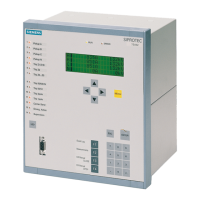2.7 Direct Remote Trip and Transmission of Binary Information
91
7SD610 Manual
C53000-G1176-C145-4
2.7 Direct Remote Trip and Transmission of Binary Information
2.7.1 Function Description
7SD610 allows the transmission of up to 4 items of binary information of any type from
one device to the other via the communication link provided for protection tasks. These
are transmitted like protection signals with high priority, i.e. very fast, and are therefore
especially suitable for the transmission of other protection signals which are generated
outside of 7SD610. They are suitable for information on the events taking place in a
substation which may also be useful in other substations (see also the specifications
in Chapter „Technical Data“).
The information can be injected into the device via binary inputs and output at the
other device via binary outputs. On both the transmitting and the receiving side the in-
tegrated user-defined CFC logic allows to perform logical operations on the signals
and on other information from the protective and monitoring functions of the devices.
Also an internal indication can be assigned via CFC to a transmission input and trans-
mitted to the remote end(s).
The used binary inputs and the signal outputs must be allocated accordingly when
configuring the input and output functions. The four high-priority signals are injected
into the device via the binary inputs „>Remote Trip1“ to „>Remote Trip4“, are
transmitted to the device of the other end and can be processed at each receiving side
with the output functions „RemoteTrip1 rec“ to „RemoteTrip4 rec“.
When assigning the binary inputs and outputs using DIGSI, you can provide the infor-
mation to be transmitted with your own designation. If, for example, a line has a unit
connected power transformer at one end and you wish to transmit trip by the Buchholz
protection as „>Remote Trip1“ to the other end, you may use the input and desig-
nate it „Buchholz TRIP“. At the other end, you designate the incoming information,
„RemoteTrip1 rec“ e.g. „Buchholz remote“, and assign it to an output trip relay. In
case of Buchholz protection trip the indications will then be given according to your
designations.
Also devices which have logged out of the line protection system (see Section 2.2.2.1
„Mode: Log out device“) can send and receive remote indications and commands.
The indications of the devices, e.g. „Rel1 Login“ of the topology exploration, can
be used to determine whether the signals of the sending devices are still available.
They are transmitted if a device x is actively involved in the communication topology.
Once a transmission fault has been detected, the time Td ResetRemote at address
4512 is started for resetting the remote signals. This means that, if the communication
is interrupted, a present receive signal retains its last status for a time Td
ResetRemote before it is reset.
No further settings are required for the transmission of binary information. The device
sends the injected information to the device at the end of the protected object.
www . ElectricalPartManuals . com

